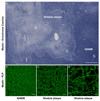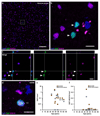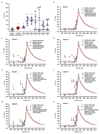Dynamics of oligodendrocyte generation in multiple sclerosis
- PMID: 30675058
- PMCID: PMC6420067
- DOI: 10.1038/s41586-018-0842-3
Dynamics of oligodendrocyte generation in multiple sclerosis
Erratum in
-
Publisher Correction: Dynamics of oligodendrocyte generation in multiple sclerosis.Nature. 2019 Feb;566(7744):E9. doi: 10.1038/s41586-019-0935-7. Nature. 2019. PMID: 30723267
Abstract
Oligodendrocytes wrap nerve fibres in the central nervous system with layers of specialized cell membrane to form myelin sheaths1. Myelin is destroyed by the immune system in multiple sclerosis, but myelin is thought to regenerate and neurological function can be recovered. In animal models of demyelinating disease, myelin is regenerated by newly generated oligodendrocytes, and remaining mature oligodendrocytes do not seem to contribute to this process2-4. Given the major differences in the dynamics of oligodendrocyte generation and adaptive myelination between rodents and humans5-9, it is not clear how well experimental animal models reflect the situation in multiple sclerosis. Here, by measuring the integration of 14C derived from nuclear testing in genomic DNA10, we assess the dynamics of oligodendrocyte generation in patients with multiple sclerosis. The generation of new oligodendrocytes was increased several-fold in normal-appearing white matter in a subset of individuals with very aggressive multiple sclerosis, but not in most subjects with the disease, demonstrating an inherent potential to substantially increase oligodendrocyte generation that fails in most patients. Oligodendrocytes in shadow plaques-thinly myelinated lesions that are thought to represent remyelinated areas-were old in patients with multiple sclerosis. The absence of new oligodendrocytes in shadow plaques suggests that remyelination of lesions occurs transiently or not at all, or that myelin is regenerated by pre-existing, and not new, oligodendrocytes in multiple sclerosis. We report unexpected oligodendrocyte generation dynamics in multiple sclerosis, and this should guide the use of current, and the development of new, therapies.
Conflict of interest statement
The authors declare no competing financial interests.
Figures












Comment in
-
Time to revisit oligodendrocytes in multiple sclerosis.Nat Med. 2019 Mar;25(3):364-366. doi: 10.1038/s41591-019-0388-4. Nat Med. 2019. PMID: 30804516 No abstract available.
References
Publication types
MeSH terms
LinkOut - more resources
Full Text Sources
Medical

